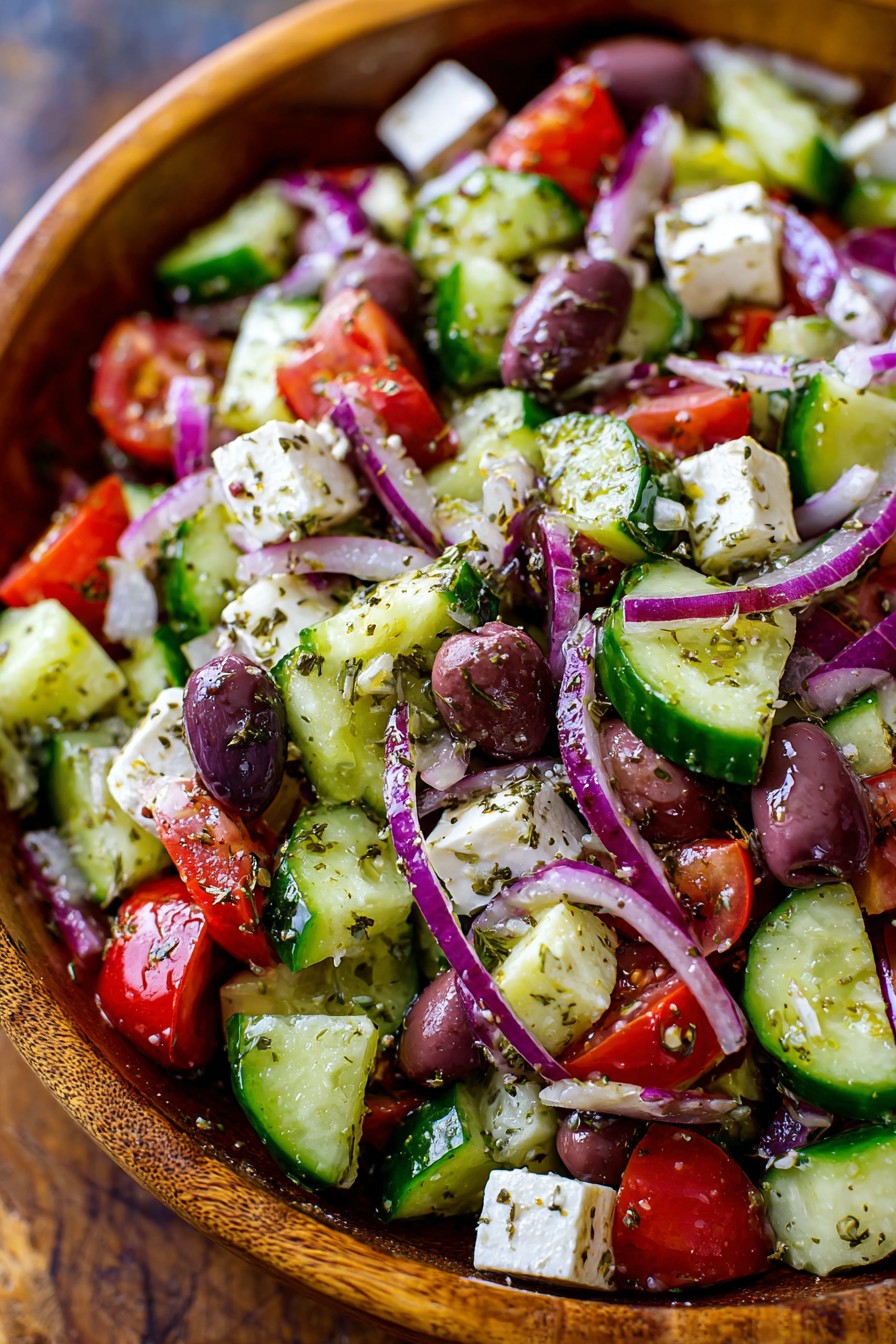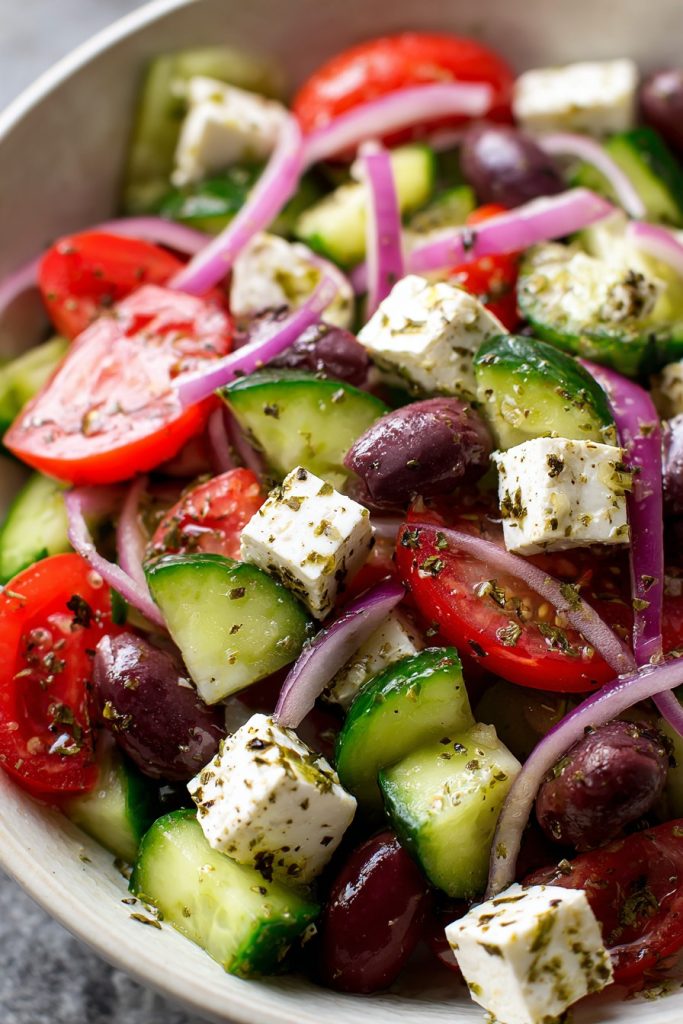A delightful Greek salad is more than just a dish; it’s a vibrant celebration of flavors and textures that come together in perfect harmony. Always a crowd-pleaser, this recipe is your ticket to a refreshing and nutritious meal that’s as easy to make as it is delicious.
Why This Recipe Works
- The combination of crisp cucumbers, juicy tomatoes, and briny olives creates a symphony of flavors that’s hard to resist.
- Feta cheese adds a creamy, tangy element that balances the freshness of the vegetables.
- A simple olive oil and lemon dressing enhances the natural flavors without overpowering them.
- This salad is incredibly versatile, making it perfect for any occasion, from a quick lunch to a fancy dinner party.
- It’s a healthy option that doesn’t skimp on taste, proving that you can have the best of both worlds.
Ingredients
- 2 large cucumbers, diced
- 4 medium tomatoes, diced
- 1 red onion, thinly sliced
- 1 cup Kalamata olives, pitted
- 1 cup feta cheese, cubed
- 1/4 cup extra virgin olive oil
- 2 tbsp lemon juice
- 1 tsp dried oregano
- Salt and pepper to taste
Equipment Needed
- Large mixing bowl
- Knife and cutting board
- Measuring cups and spoons
- Whisk or fork for dressing
Instructions

Step 1: Prepare the Vegetables
Start by washing all your vegetables thoroughly. Dice the cucumbers and tomatoes into bite-sized pieces, ensuring they’re roughly the same size for a uniform look and feel. Thinly slice the red onion to add a sharp, crunchy contrast to the salad. Remember, the key to a great Greek salad is in the freshness of its ingredients, so don’t skimp on quality here.
Step 2: Combine the Base Ingredients
In your large mixing bowl, gently toss together the diced cucumbers, tomatoes, sliced red onion, and Kalamata olives. The goal is to mix them without crushing the tomatoes, so a light hand is essential. This step is where the salad starts to come to life, with each ingredient adding its unique texture and flavor to the mix.
Step 3: Add the Feta Cheese
Cube the feta cheese into small, bite-sized pieces and sprinkle them over the salad. The feta’s creamy texture and tangy taste are what make this salad distinctly Greek, so distribute it evenly to ensure every bite is as flavorful as the last. For an extra touch of authenticity, you can use Greek feta, which tends to be creamier and more flavorful.
Step 4: Whisk Together the Dressing
In a small bowl, whisk together the extra virgin olive oil, lemon juice, dried oregano, and a pinch of salt and pepper. The dressing should be emulsified, with the oil and lemon juice fully combined. Taste and adjust the seasoning as needed. This simple dressing is the perfect complement to the fresh vegetables, adding brightness and depth without overwhelming them.
Step 5: Dress the Salad and Serve
Drizzle the dressing over the salad and toss gently to coat all the ingredients evenly. Let the salad sit for about 10 minutes before serving to allow the flavors to meld together. Serve chilled or at room temperature, garnished with a little extra oregano if desired. This salad is best enjoyed fresh but can be stored in the refrigerator for a day or two.
Tips and Tricks
For the best flavor, use the freshest ingredients you can find. The quality of your tomatoes and cucumbers will make or break this salad. If you’re not a fan of raw onion, you can soak the sliced onion in cold water for about 10 minutes to mellow its sharpness. When it comes to feta cheese, opting for a block that you cube yourself rather than pre-crumbled feta will give you a creamier texture and better flavor. Lastly, if you’re making this salad ahead of time, consider adding the dressing just before serving to keep the vegetables crisp.
Recipe Variations
- Add some protein: Grilled chicken or shrimp can turn this salad into a hearty main dish.
- Go grain-free: For a lighter version, skip the traditional addition of barley or bread and keep it strictly vegetables and cheese.
- Spice it up: Add a pinch of red pepper flakes to the dressing for a little heat.
- Make it vegan: Substitute the feta cheese with a vegan cheese alternative or simply omit it for a dairy-free version.
- Add more veggies: Bell peppers, artichoke hearts, or avocado can add more color and texture to the salad.
Frequently Asked Questions
Can I make this salad ahead of time?
Yes, you can prepare the ingredients ahead of time, but it’s best to add the dressing just before serving to keep the vegetables crisp. If you do dress the salad ahead of time, expect the vegetables to soften slightly as they marinate in the dressing.
What can I substitute for Kalamata olives?
If you can’t find Kalamata olives, any other briny olive like black olives or green olives can work as a substitute. Just keep in mind that the flavor profile of the salad will change slightly depending on the type of olive you use.
How long does this salad last in the fridge?
This salad is best enjoyed fresh but can be stored in an airtight container in the refrigerator for up to 2 days. The vegetables will soften over time, especially after the dressing is added, so it’s not ideal for meal prepping far in advance.
Summary
This Greek salad recipe is a refreshing, flavorful, and healthy dish that’s perfect for any occasion. With its simple ingredients and easy preparation, it’s a foolproof way to bring a taste of the Mediterranean to your table. Whether you’re serving it as a side or a main, it’s sure to be a hit.





